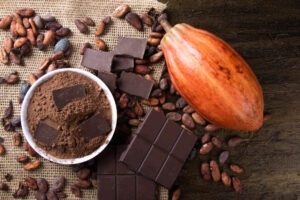Everyone has a go-to, preferred flavor. But how much do you actually know about the various chocolate varieties? Do you understand the distinction between semisweet and bittersweet? Alternatively, why is milk chocolate harder than white chocolate? It all depends on the materials and the process used to manufacture the chocolate.
The three main variety of chocolates are:
- White chocolate
- Milk chocolate
- Dark chocolate
Continue reading to discover more about the distinctive tastes, ingredients, and qualities of each type of chocolate.
Types of chocolate
Chocolate Liquor
All varieties of chocolate start with chocolate liquor, sometimes known as unsweetened chocolate. Cacao nibs, which are found inside the cocoa bean, are used to make this thick, dark chocolate paste. The nibs have a smooth texture after being carefully ground. This paste becomes a liquid when heated, which can then be shaped into bars or chips. All cocoa used in chocolate liquor is the only ingredient. This mixture separates into cocoa butter and cocoa powder when put under a lot of pressure (also called cocoa solids). Chocolate liquor does not actually contain alcohol, despite its name.
White Chocolate
White chocolate can be easily distinguished because to its cream or ivory color. Sugar, cocoa butter, milk, vanilla, and lecithin are all combined to create it (an emulsifier that helps the ingredients blend together). The pleasant vanilla scent of white chocolate is derived from these components. The flavor profile of white chocolate is frequently described as being mostly sweet with strong undertones of sweetened condensed milk and vanilla. Due to its basis of cocoa butter and high sugar and milk content, good grade white chocolate will have a rich, smooth, and creamy feel.
Milk Chocolate
We all have fond memories of milk chocolate from our childhood. The most common form of chocolate is generally described as milk chocolate due to its light brown color, creamy texture, and sweet flavor. It is created by blending milk, sugar, and chocolate liquor (cocoa butter and solids). To improve its smoothness, an emulsifier, like soy lecithin, is occasionally added. Milk chocolate must include at least 10% chocolate liquor and 12% milk in order to meet FDA definitions.
A decent middle-of-the-road chocolate is thought to be milk chocolate. Although it is not nearly as sweet and soft as white chocolate, it is often sweeter and has a softer texture than dark chocolate. Milk chocolate has a shelf life of roughly 16 months when stored properly. When looking for a chocolate treat or gift that everyone will love, milk chocolate is a fantastic option. When a recipe calls for a lighter chocolate flavor, it can be used; we recommend giving these chocolate waffles a try.
Dark Chocolate
The second most popular kind of chocolate is dark chocolate, which stands out for its unique deep brown color. It is notably less sweet than milk chocolate and is also referred to as black or semisweet chocolate. Due to the numerous articles that have been written about the health advantages of dark chocolate, its appeal has increased recently.
Compositionally, dark chocolate is quite straightforward. Usually, only two ingredients—chocolate liquor and sugar—are used to make it. Soy lecithin, an emulsifier, and vanilla extract are occasionally added in trace amounts. Dark chocolate must, by FDA definition, contain at least 15% chocolate liquor, though it typically has closer to 50%. The majority of premium dark chocolate is dairy-free and can be a fantastic vegan-friendly chocolate. Dark chocolate has a harder texture than milk chocolate or white chocolate because it contains less sugar and less dairy. Because of this, breaking a piece of well-tempered dark chocolate in half will result in a satisfying snap.
Bittersweet Chocolate
Since people began to learn more about cacao and cocoa percentages, bittersweet chocolate has become very popular. When people started saying that you should only eat dark chocolate with a cocoa content of 70% or more to achieve the most health advantages, this type of chocolate, also known as extra-dark chocolate, gained popularity. The popularity of greater cocoa content dark chocolate has increased as a result of the recent upsurge in bean-to-bar chocolate producers and craft chocolate.
The FDA defines semisweet and bittersweet chocolate as having more than 35% chocolate liquor, however they often have at least 50% cocoa liquor. Typically, bittersweet chocolate has a cocoa level of 66% or more (the added sugar usually less than one-third of the total content).
Cocoa Powder
When chocolate liquor is separated under intense pressure and the resulting cocoa solids are ground into a powder, cocoa powder is the outcome. In general, unsweetened cocoa powder is made entirely of cocoa.
Natural cocoa powder and dutch-processed cocoa are the two varieties. The color of natural cocoa is a lighter shade of brown, and it tastes strongly like chocolate and is frequently acidic. Dutch cocoa is unprocessed cacao that has undergone alkalization to balance its acidity. The dutch-process imparts a rich, warm hue and a little mellower flavor to the cocoa powder.
Ruby Chocolate
In 2017, Belgian chocolatier Barry Callebaut developed a fourth variety of chocolate: ruby chocolate. This unusual chocolate stands out from other chocolates because of its reddish-pink color. Because this is a relatively recent discovery (and the precise cacao-making process developed by Barry Callebaut is proprietary), there is no standard FDA definition for it. Rather, it is a color derived from a particular type of cacao — the ruby cocoa bean (a bean typically grown in Ecuador, Brazil, and the Ivory Coast).
Conclusion
The amount of cocoa that each type of chocolate contains serves to distinguish it from the others. Dark chocolate is frequently thought to be healthier than milk chocolate because it has a higher cocoa content on average and more antioxidants. Overall, the type of chocolate selected ultimately relies on taste preferences and intended application.

